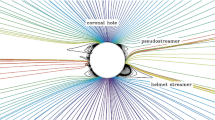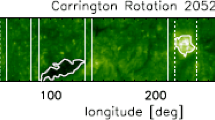Abstract
Recent models of the fast solar wind are characterized by low coronal electron temperatures while proton, α-particle, and minor ion temperatures are expected to be quite high and generally anisotropic, including large temperatures perpendicular to the magnetic field and parallel beams. This entails that the electric field should be relatively unimportant and that solar wind outflows with both high asymptotic flow speeds but maintaining a low mass flux should be a natural outcome of plasma expansion along open polar magnetic field lines. In this chapter we will explain why such changes with respect to the classical, electron thermally driven solar wind have come about and outline the most important remaining concerning the astrophysics of coronal winds.
The progress we have seen in the last decade is largely due observations made with instruments onboard Ulysses (McComas et al. in Space Sci. Rev. 72:93, 1995) and SOHO (Fleck et al. in The SOHO Mission, Kluwer, Dordrecht, 1995). These observations have spawned a new understanding of solar wind energetics, and the consideration of the chromosphere, corona, and solar wind as a unified system.
We will begin by giving our own, highly biased, “pocket history” of solar wind theory highlighting the problems that had to be resolved in order to make the original Parker formulation of thermally driven winds conform with observational results. Central to this discussion are questions of how the wind’s asymptotic flow speed and mass flux are set, but we will also touch upon higher order moments such as the ion and electron temperatures and heat fluxes as well as the possible role of Alfvén waves and particle effects in driving the solar wind outflow. Solar wind scaling laws will be discussed in the context of the origin of slow and fast wind streams.










Similar content being viewed by others
References
H. Alfvén, On the solar corona. Ark. Mat. Astron. Fys. 27A(25), 1–23 (1941)
H. Alfvén, Granulation, magneto-hydrodynamic waves, and the heating of the solar corona. Mon. Not. R. Astron. Soc. 107(2), 211–219 (1947)
S.K. Antiochos, Z. Mikić, V.S. Titov, R. Lionello, J.A. Linker A model for the sources of the slow solar wind. Astrophys. J. 731, 112 (2011)
I.W. Axford, The polar wind and the terrestrial helium budget. J. Geophys. Res. 73, 6855 (1968)
W.I. Axford, J.F. McKenzie, The origin of high speed solar wind streams, in Solar Wind Seven Colloquium, ed. by E. Marsch, R. Schwenn (1992), pp. 1–5
J.W. Belcher, L. Davis Jr., Large-amplitude Alfvén waves in the interplanetary medium, 2. J. Geophys. Res. 76, 3534–3563 (1971)
L. Biermann, Zur Deutung der chromosphärischen Turbulenz und des Exzesses der UV-Strahlung der Sonne. Naturwissenshaften 33, 118–119 (1946)
L. Biermann, Über der Ursache der chromosphärischen Turbulenz und des UV-Exzesses der Sonnenstrahlung. Z. Astrophys. 25, 161–177 (1948)
L. Biermann, Kometenschweife und solare Korpuskularstrahlung. Z. Astrophys. 29, 274 (1951)
L. Biermann, Solar corpuscular radiation and the interplanetary gas. Observatory 77, 109–110 (1957)
S.I. Braginskii, Transport processes in a plasma. Rev. Plasma Phys. 1, 205 (1965)
B.D.G. Chandran, B. Li, B.N. Rogers, E. Quataert, K. Germaschewski, Perpendicular ion heating by low-frequency Alfvén-wave turbulence in the solar wind. Astrophys. J. 720, 503–515 (2010). doi:10.1088/0004-637X/720/1/503
B.D.G. Chandran, T.J. Dennis, E. Quataert, S.D. Bale, Advances in fluid modeling of the solar wind. Part 1. Electron and anisotropic proton temperatures from the collisionless dissipation of Alfven wave turbulence (2011)
S. Chapman, The viscosity and thermal conductivity of a completely ionized gas. Astrophys. J. 120, 151–155 (1954)
S. Chapman, Notes on the solar corona and the terrestrial ionosphere. Smithson. Contrib. Astrophys. 2, 1 (1957)
S. Chapman, V.C.A. Ferraro, The electrical state of solar streams of corpuscles. Mon. Not. R. Astron. Soc. 89, 470 (1929)
S.R. Cranmer, Coronal holes. Living Rev. Sol. Phys. 6, 3 (2009). http://www.livingreviews.org/lrsp-2009-3
S.R. Cranmer, A.A. van Ballegooijen, R.J. Edgar, Self-consistent coronal heating and solar wind acceleration from anisotropic magnetohydrodynamic turbulence. Astrophys. J., Suppl. Ser. 171, 520–551 (2007). doi:10.1086/518001
B. De Pontieu, S.W. McIntosh, M. Carlsson, V.H. Hansteen, T.D. Tarbell, C.J. Schrijver, A.M. Title, R.A. Shine, S. Tsuneta, Y. Katsukawa, K. Ichimoto, Y. Suematsu, T. Shimizu, S. Nagata, Chromospheric Alfvénic waves strong enough to power the solar wind. Science 318, 1574 (2007). doi:10.1126/science.1151747
H.G. Demars, R.W. Schunk, A multi-ion generalized transport model of the polar wind. J. Geophys. Res. 99, 2215–2226 (1994)
P. Dmitruk, L.J. Milano, W.H. Matthaeus, Wave-driven turbulent coronal heating in open field line regions: nonlinear phenomenological model. Astrophys. J. 548, 482–491 (2001). doi:10.1086/318685
B. Edlén, An attempt to identify the emission lines in the spectrum of the solar corona. Ark. Mat. Astron. Fys. 28B(1), 1–4 (1942)
L.A. Fisk, Acceleration of the solar wind as a result of the reconnection of open magnetic flux with coronal loops. J. Geophys. Res. 108, 1157 (2003). doi:10.1029/2002JA009284
B. Fleck, V. Domingo, A. Poland (Eds.), The SOHO Mission (Kluwer, Dordrecht, 1995)
S.E. Forbush, P.S. Gill, M.S. Vallarta, On the mechanism of sudden increases of cosmic radiation associated with solar flares. Rev. Mod. Phys. 21, 44–48 (1949)
J. Geiss, G. Gloeckler, R. von Steiger, Origin of the solar wind from composition data. Space Sci. Rev. 72, 49–60 (1995). doi:10.1007/BF00768753
G. Gloeckler, T.H. Zurbuchen, J. Geiss, Implications of the observed anticorrelation between solar wind speed and coronal electron temperature. J. Geophys. Res. 108, 1158 (2003). doi:10.1029/2002JA009286
W. Grotrian, Über den Intensitätsverhältnis der Koronalinien. Z. Astrophys. 7, 26–45 (1933)
W. Grotrian, Zur Frage der Deutung der Linien im Spektrum der Sonnenkorona. Naturwissenschaften 27, 214 (1939)
V. Hansteen, E. Leer, Coronal heating, densities, and temperatures and solar wind acceleration. J. Geophys. Res. 100(A11), 21577–21593 (1995)
V.H. Hansteen, E. Leer, T.E. Holzer, The role of helium in the outer solar atmosphere. Astrophys. J. 482, 498 (1997). doi:10.1086/304111
J.V. Hollweg, Alfvén waves in a two-fluid model of the solar wind. Astrophys. J. 181, 547–566 (1973)
J.V. Hollweg, Some physical processes in the solar wind. Rev. Geophys. Space Phys. 16, 689–720 (1978)
T.E. Holzer, Heating and acceleration of the solar plasma (Tutorial talk), in Solar Wind 11/SOHO 16, Connecting Sun and Heliosphere. ESA Special Publication, vol. 592 (2005), p. 115
T.E. Holzer, W.I. Axford, The theory of stellar winds and related flows. Annu. Rev. Astron. Astrophys. 8, 31 (1970). doi:10.1146/annurev.aa.08.090170.000335
S.A. Jacques, Momentum and energy transport by waves in the solar atmosphere and solar wind. Astrophys. J. 215, 942–951 (1977). doi:10.1086/155430
Å.M. Janse, Ø. Lie-Svendsen, E. Leer, Solar wind originating in funnels: fast or slow (2007, submitted)
S.A. Jaques, Solar wind models with Alfven waves. Astrophys. J. 226, 632–649 (1978). doi:10.1086/156647
M.A. Killie, Å.M. Janse, Ø. Lie-Svendsen, E. Leer, Improved transport equations for fully ionized gases. Astrophys. J. 604, 842–849 (2004). doi:10.1086/382023
J.L. Kohl, G. Noci, S.R. Cranmer, J.C. Raymond, Ultraviolet spectroscopy of the extended solar corona. Astron. Astrophys. Rev. 13, 31–157 (2006). doi:10.1007/s00159-005-0026-7
J.M. Laming, Non-Wkb models of the first ionization potential effect: implications for solar coronal heating and the coronal helium and neon abundances. Astrophys. J. Lett. 695, 954–969 (2009). doi:10.1088/0004-637X/695/2/954
E. Leer, T.E. Holzer, Energy addition in the solar wind. J. Geophys. Res. 85, 4681–4688 (1980)
E. Leer, T.E. Holzer, E.C. Shoub, Solar wind from a corona with a large helium abundance. J. Geophys. Res. 97, 8183–8201 (1992)
X. Li, S.R. Habbal, J. Kohl, G. Noci, The effect of temperature anisotropy on observations of Doppler dimming and pumping in the inner corona. Astrophys. J. Lett. 501, 133 (1998). doi:10.1086/311428
Ø. Lie-Svendsen, M.H. Rees, An improved kinetic model for the polar outflow of a minor ion. J. Geophys. Res. 101, 2415–2434 (1996). doi:10.1029/95JA02690
F. Malara, M. Velli, Wave-based heating mechanisms for the solar corona, in Solar Coronal Structures, ed. by V. Rusin, P. Heinzel, J.-C. Vial. IAU Colloq., vol. 144 (1994), pp. 443–451
E. Marsch, in Kinetic Physics of the Solar Corona and Solar Wind, ed. by R. Schwenn, E. Marsch (1991), pp. 45–133
E. Marsch, Kinetic physics of the solar wind plasma. Living Rev. Sol. Phys. 3, 1 (2006)
W.H. Matthaeus, M. Velli, Who needs turbulence? Space Sci. Rev. (2011). doi:10.1007/s11214-011-9793-9
D.J. McComas, K.L. Phillips, S.J. Bame, J.T. Gosling, B.E. Goldstein, M. Neugebauer, ULYSSES solar wind observations to 56 deg South. Space Sci. Rev. 72, 93 (1995)
D.J. McComas, R.W. Ebert, H.A. Elliott, B.E. Goldstein, J.T. Gosling, N.A. Schwadron, R.M. Skoug, Weaker solar wind from the polar coronal holes and the whole Sun. Geophys. Res. Lett. 351, 18103 (2008). doi:10.1029/2008GL034896
S.W. McIntosh, B. de Pontieu, M. Carlsson, V. Hansteen, P. Boerner, M. Goossens, Alfvénic waves with sufficient energy to power the quiet solar corona and fast solar wind. Nature 475, 477–480 (2011). doi:10.1038/nature10235
M.P. Nakada, A study of the composition of the lower solar corona. Sol. Phys. 7, 303 (1969)
M. Neugebauer, C.W. Snyder, Solar plasma experiment. Science 138, 1095–1097 (1962)
L. Ofman, Wave modeling of the solar wind. Living Rev. Sol. Phys 7, 4 (2009). http://www.livingreviews.org/lrsp-2010-4
E.L. Olsen, E. Leer, A study of solar wind acceleration based on gyrotropic transport equations. J. Geophys. Res. 104, 9963 (1999)
E.N. Parker, Dynamics of the interplanetary gas and magnetic fields. Astrophys. J. 128, 664 (1958)
E.N. Parker, Dynamical theory of the solar wind. Space Sci. Rev. 4, 666 (1965)
E.N. Parker, Heating solar coronal holes. Astrophys. J. 372, 719–727 (1991). doi:10.1086/170015
N.E. Raouafi, S.K. Solanki, Sensitivity of solar off-limb line profiles to electron density stratification and the velocity distribution anisotropy. Astron. Astrophys. 445, 735–745 (2006). doi:10.1051/0004-6361:20042568
R. Rosner, W.H. Tucker, G.S. Vaiana, Dynamics of the quiescent solar corona. Astrophys. J. 220, 643–645 (1978). doi:10.1086/155949
R.W. Schunk, Mathematical structure of transport equations for multispecies flows. Rev. Geophys. Space Phys. 15, 429–445 (1977)
N.A. Schwadron, D.J. McComas, Solar wind scaling law. Astrophys. J. 599, 1395–1403 (2003). doi:10.1086/379541
J.V. Shebalin, W.H. Matthaeus, D. Montgomery, Anisotropy in MHD turbulence due to a mean magnetic field. J. Plasma Phys. 29, 525–547 (1983). doi:10.1017/S0022377800000933
L. Spitzer, R. Härm, Transport phenomena in a completely ionized gas. Phys. Rev. 89, 977–981 (1953). doi:10.1103/PhysRev.89.977
J.P. St.-Maurice, R.W. Schunk, Diffusion and heat flow equations for the mid-latitude topside ionosphere. Planet. Space Sci. 25, 907–920 (1977). doi:10.1016/0032-0633(77)90003-4
T.K. Suzuki, S.i. Inutsuka, Making the corona and the fast solar wind: a self-consistent simulation for the low-frequency Alfvén waves from the photosphere to 0.3 AU. Astrophys. J. Lett. 632, 49–52 (2005). doi:10.1086/497536
S. Tomczyk, S.W. McIntosh, S.L. Keil, P.G. Judge, T. Schad, D.H. Seeley, J. Edmondson, Alfvén waves in the solar corona. Science 317, 1192 (2007). doi:10.1126/science.1143304
M. Velli, From supersonic winds to accretion: comments on the stability of stellar winds and related flows. Astrophys. J. Lett. 432, 55–58 (1994). doi:10.1086/187510
A. Verdini, M. Velli, Alfvén waves and turbulence in the solar atmosphere and solar wind. Astrophys. J. 662, 669–676 (2007). doi:10.1086/510710
A. Verdini, M. Velli, W.H. Matthaeus, S. Oughton, P. Dmitruk, A turbulence-driven model for heating and acceleration of the fast wind in coronal holes. Astrophys. J. Lett. 708, 116–120 (2010). doi:10.1088/2041-8205/708/2/L116
R. von Steiger, Transition region: first ionization potential effect, in Encycl. Astron. Astrophys., ed. by P. Murdin, (2000). doi:10.1888/0333750888/2265
Y.M. Wang, Flux-tube divergence, coronal heating, and the solar wind. Astrophys. J. Lett. 410, 123–126 (1993). doi:10.1086/186895
Y.M. Wang, N.R. Sheeley Jr., Solar wind speed and coronal flux-tube expansion. Astrophys. J. 355, 726–732 (1990). doi:10.1086/168805
Y.M. Wang, N.R. Sheeley Jr., Why fast solar wind originates from slowly expanding coronal flux tubes. Astrophys. J. Lett. 372, 45–48 (1991). doi:10.1086/186020
Acknowledgements
This work was carried out in part at the Jet Propulsion Laboratory, California Institute of Technology, under a contract with the National Aeronautics and Space Administration.
Author information
Authors and Affiliations
Corresponding author
Rights and permissions
About this article
Cite this article
Hansteen, V.H., Velli, M. Solar Wind Models from the Chromosphere to 1 AU. Space Sci Rev 172, 89–121 (2012). https://doi.org/10.1007/s11214-012-9887-z
Received:
Accepted:
Published:
Issue Date:
DOI: https://doi.org/10.1007/s11214-012-9887-z




